Bitlayer is the first Bitcoin Layer 2 network security equivalent project based on the BitVM solution, aiming to provide security equivalent to Bitcoin and support Turing completeness, meaning it can execute any possible computation or program.
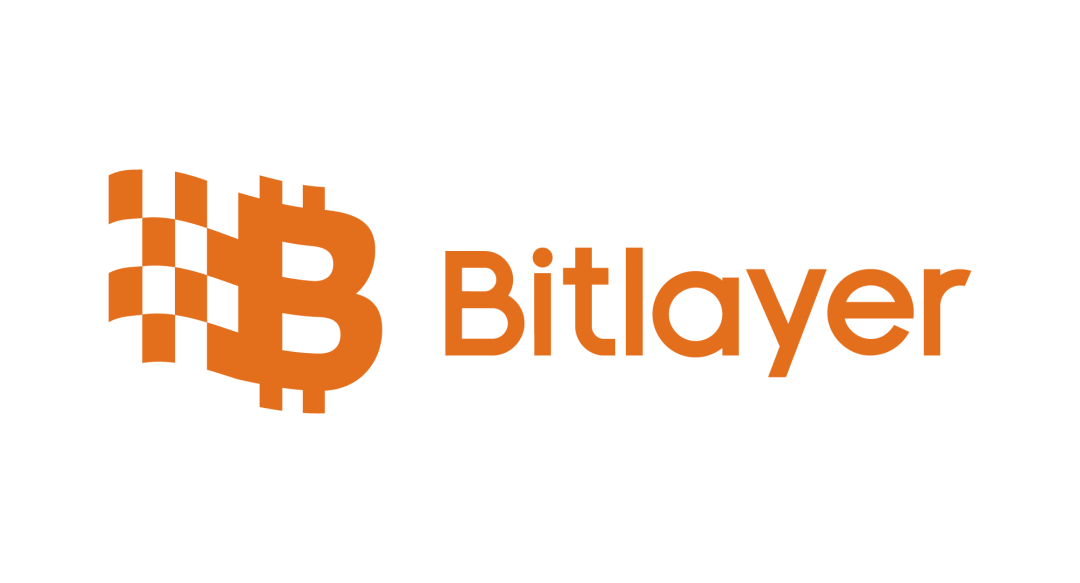
The core goal of Bitlayer is to address the trade-off between the security and Turing completeness of Bitcoin's Layer 2 technology. Its design inspiration comes from BitVM, DLC/LN (Discreet Log Contracts/Lightning Network) technology protocols, and multiple VMs (including EVM, Ethereum Virtual Machine).
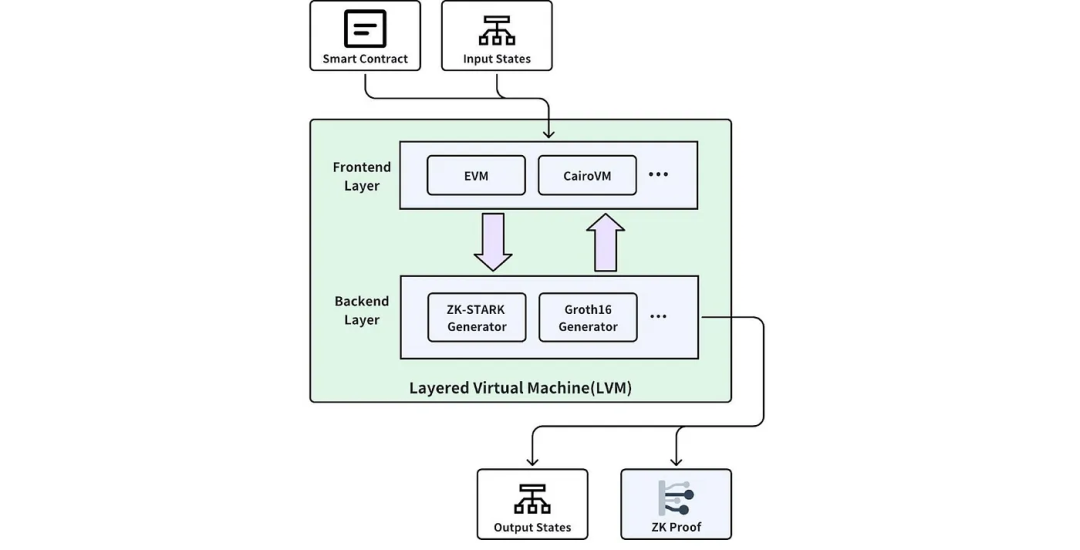
The project's technical team has abstracted three key tasks from these inspirations:
- Trustless entry and exit of Layer 1 assets
- State transition using a Turing-complete Layer 2 virtual machine
- Layer 1 validation of the validity of Layer 2 state transitions
Its core functions and operation principles are built around several key technical components to support more complex application scenarios, such as smart contract execution, high-throughput transaction processing, and cross-chain asset transfers.
1. Core Functions
- Turing-complete smart contract support: Bitlayer implements a Turing-complete virtual machine (called BitVM) compatible with the Ethereum Virtual Machine (EVM), allowing developers to write and execute complex smart contracts on Bitcoin. This introduces decentralized application (DApp) development possibilities to the Bitcoin ecosystem that are not supported by native Bitcoin functionality.
- Efficient transaction processing: Utilizing optimistic rollups and layered verification mechanisms, Bitlayer significantly improves transaction processing speed and system scalability. This allows for processing a large number of transactions on the second layer network, with on-chain verification only required in case of disputes, reducing the burden on the main chain and lowering transaction costs.
- Secure cross-chain asset transfer: Through OP_DLC bridge, Bitlayer achieves secure and seamless transfer of Bitcoin and other assets between the Bitcoin main chain and the second layer. This bridge technology supports the liquidity of assets across different blockchain platforms while ensuring asset security and user control.
2. Core Mechanism
As a Bitcoin Layer 2 solution based on BitVM, Bitlayer adopts layered virtual machine technology (LVM), utilizing zero-knowledge proofs (ZKP) and optimistic verification mechanisms to support various complex computations. Additionally, Bitlayer builds a bidirectional locked asset bridge with OP_DLC (Optimistic Discreet Log Contracts) and BitVM, achieving security equivalent to Bitcoin's Layer 1.
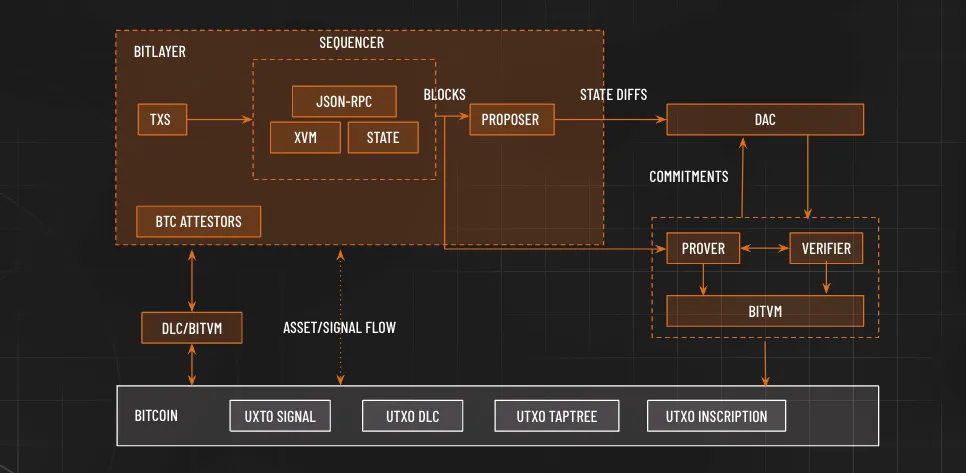
BitVM
BitVM is the core component of the Bitlayer project, a Turing-complete virtual machine designed specifically for the Bitcoin ecosystem. Its main purpose is to extend the functionality and programmability of Bitcoin without sacrificing its inherent security and decentralization. The following is a detailed introduction to BitVM:
Design Goals
The design goal of BitVM is to overcome some limitations of the native Bitcoin protocol, particularly in smart contracts and complex computational capabilities. While Bitcoin is one of the most secure blockchains, it does not inherently support complex smart contracts, limiting its use in certain application scenarios such as decentralized finance (DeFi).
Turing Completeness
BitVM is Turing-complete, meaning it can execute any complex computational task given sufficient resources. This feature allows developers to design and run various complex decentralized applications on the Bitcoin network, such as automated trading strategies, financial derivatives, and smart contracts.
In summary, BitVM is a key technology of the Bitlayer project, providing a secure, scalable, and feature-rich virtual machine to better meet current and future blockchain application needs. It not only addresses Bitcoin's shortcomings in smart contracts and high throughput applications but also maintains its security and decentralization as a top-tier cryptocurrency.
Layered Virtual Machine Technology (LVM)
Bitlayer's layered virtual machine technology (LVM) is an innovative architectural design aimed at enhancing the computational capabilities and programmability of the Bitcoin network while maintaining its core security and decentralization. This technology allows for the execution of complex smart contracts and other applications on Bitcoin's second layer without overburdening the main chain. The following details the key components and working principles of this technology.
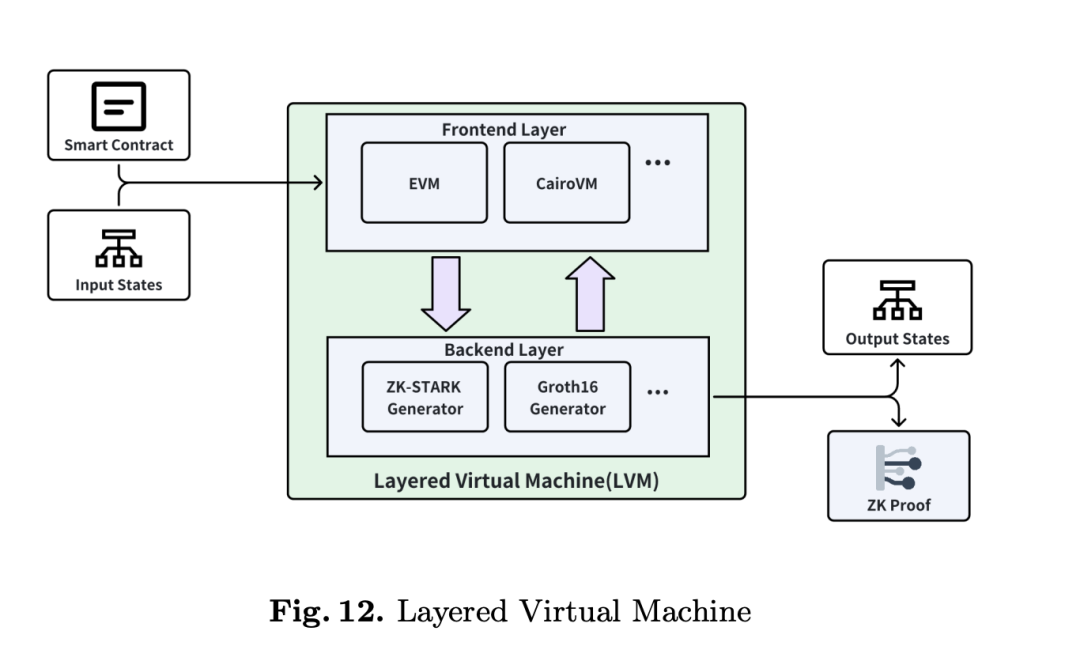
Key Components
- Front-end execution environment: The front-end execution environment is primarily responsible for handling smart contract execution. It can support multiple smart contract languages and frameworks, enabling developers to choose the most suitable tools and languages for specific applications.
- Back-end verification environment: The back-end environment focuses on verifying the results of front-end execution. This part typically utilizes zero-knowledge proof technology to ensure the correctness of computation results without revealing specific execution details.
Working Principles
The core idea of the layered virtual machine is to separate computation and verification. This layered architecture allows for a significant amount of computation to be processed on the second layer, with only necessary verification information submitted to the Bitcoin main chain, greatly reducing the burden on the main chain.
- Executing smart contracts:
- Developers deploy smart contracts in the front-end execution environment. These contracts can be financial derivatives, games, or other applications requiring complex logic processing.
- Contract execution occurs on the second layer rather than directly on Bitcoin's main chain.
- Generating zero-knowledge proofs:
- Once smart contract execution is completed, the back-end verification environment generates zero-knowledge proofs that can verify the correctness of front-end execution without revealing specific details.
- These proofs can then be submitted to the Bitcoin main chain for anyone needing to verify the computations.
- On-chain verification:
- After zero-knowledge proofs are submitted to the Bitcoin main chain, anyone can verify the error-free execution of smart contracts without the need for recomputation.
- This not only ensures the transparency and verifiability of computations but also protects the privacy of execution details.
Advantages
- Efficiency: By processing the majority of computations on the second layer, the layered virtual machine significantly reduces the pressure on the main chain, improving the overall system throughput and efficiency.
- Flexibility: Supporting multiple smart contract languages and execution environments provides developers with a wide range of choices, promoting innovation and development across various applications.
- Security: Utilizing zero-knowledge proof technology protects user privacy while ensuring the correctness and tamper resistance of computation results.
Layered virtual machine technology is a key technology that Bitlayer employs to add complex smart contract functionality to the Bitcoin network without sacrificing security and decentralization. This innovative technical framework provides new possibilities for extending Bitcoin's functionality, enabling it to better serve various modern blockchain application needs.
Zero-Knowledge Proofs (ZKP)
Zero-Knowledge Proofs (ZKP) is an encryption technology that allows one party (the prover) to prove a statement to another party (the verifier) as true without revealing any information other than the truth of the statement. This technology ensures data integrity and security while protecting privacy. In the Bitlayer project, zero-knowledge proof technology is used to enhance security, improve efficiency, and protect user privacy.
Basic Principles
The core of zero-knowledge proofs is the ability to prove the correctness of information without revealing any specific content about that information. For example, a prover can prove knowledge of a password without revealing the password itself. This is achieved through a series of mathematical challenges and responses, where only the person with the correct information can successfully solve them.
Application in Bitlayer
In Bitlayer, zero-knowledge proofs are used in several key aspects:
- Enhancing privacy protection: By using ZKP, users can prove they have sufficient funds for transactions without revealing the specific amount of their account balance. This protects user privacy and ensures network security.
- Improving transaction efficiency: In traditional blockchain systems, the details of each transaction need to be publicly recorded on the chain, which can lead to privacy leaks and network congestion. Using ZKP, only the validity of transactions needs to be proven without revealing all the transaction details, reducing data transmission and storage requirements.
- Secure execution of smart contracts: Using ZKP in smart contracts ensures the correctness of contract execution while not revealing the internal state and logic of the contract, which is particularly important for applications involving sensitive data and logic.
Technical Challenges
While zero-knowledge proofs offer many advantages, they also face some technical challenges, including:
- Computational complexity: The process of generating and verifying zero-knowledge proofs is typically computationally intensive, which may lead to performance issues, especially in resource-constrained environments.
- Design complexity: Designing an effective and secure zero-knowledge proof system requires advanced encryption knowledge and precise implementation, as incorrect design may lead to security vulnerabilities.
- Interoperability issues: Zero-knowledge proof standards and implementations may be incompatible across different systems and platforms, limiting their cross-platform application capabilities.
In the Bitlayer project, zero-knowledge proof technology is a key component, enabling the Bitcoin second-layer network to provide both security and efficiency while supporting various complex and sensitive blockchain applications.
Optimistic Verification
Optimistic verification is a technology used in second-layer blockchain solutions, particularly suitable for expanding the capacity of the main chain and reducing its load. This technology assumes that participants' behavior is honest and allows for the execution of transactions and contracts without immediate verification. Verification is only triggered in case of disputes, effectively reducing the number of transactions on the main chain and improving the overall network performance and scalability. In the Bitlayer project, optimistic verification is one of the key technologies for achieving high throughput and low latency.
Working Principle
The basic principle of optimistic verification is that most transactions or contract executions are assumed to be correct, and the verification process is only triggered when necessary. This reduces the need for on-chain operations, thereby reducing transaction costs and delays while increasing the overall system's scalability.
- Submission phase: Transactions or state changes are first executed on the second layer network (such as Bitlayer) and assumed to be valid. This phase does not require immediate on-chain verification, significantly reducing latency and costs.
- Challenge window: Each submitted state or transaction has a "challenge window" during which network participants can dispute the submitted state. If there are no challenges within this window, the transaction is considered valid.
- Dispute resolution: If a challenge occurs, disputes must be resolved through on-chain verification. This involves submitting evidence to prove the validity or invalidity of the state. If the challenge is successful, the incorrect state is rolled back; if the challenge fails, the state is confirmed.
Application in Bitlayer
In the Bitlayer project, optimistic verification significantly improves transaction processing speed and system scalability while maintaining the core security properties of Bitcoin. The following are key applications of Bitlayer utilizing optimistic verification:
- Smart contract execution: Bitlayer can execute complex smart contracts on the second layer and only requires on-chain verification in case of disputes. This allows Bitlayer to support more complex and feature-rich applications than the native Bitcoin protocol while maintaining core security and decentralization.
- Batch transaction processing: Through optimistic verification, Bitlayer can process a large number of transactions on the second layer and then record the final state of these transactions as a single batch on the Bitcoin main chain. This reduces the burden on the main chain and increases overall transaction throughput.
- Cost efficiency: By reducing the need for immediate on-chain verification, optimistic verification significantly lowers transaction costs, making small-value transactions economically feasible on the blockchain.
Challenges and Considerations
While optimistic verification offers significant performance advantages, it also presents some challenges, primarily in terms of security and data integrity. Since it relies on a challenge mechanism to ensure transaction correctness, the system must be carefully designed to prevent fraudulent behavior and ensure that network participants can respond effectively to any potential challenges. Additionally, the design of the challenge window duration and dispute resolution mechanism needs to be meticulous to ensure fairness and efficiency.
In summary, optimistic verification provides an effective path for second-layer solutions like Bitlayer to extend blockchain systems by reducing the need for on-chain operations, significantly improving system scalability and economic efficiency while ensuring security.
OP_DLC Bridge (Optimistic Discreet Log Contracts Bridge)
The OP_DLC Bridge is a key technology in the Bitlayer project for implementing cross-chain asset transfers. This technology is based on Discreet Log Contracts (DLC) and optimistic protocols, aiming to provide a secure, reliable, and decentralized method for assets to circulate between the Bitcoin main chain and the Bitlayer second layer.
Discreet Log Contracts (DLC)
Discreet Log Contracts are a form of smart contract based on Bitcoin, allowing the execution of contracts based on predefined conditions without relying on external oracles. DLC implementation primarily relies on Bitcoin scripts and multisignature technology, ensuring contract execution is entirely on-chain, transparent, and tamper-proof.
Working Principle of OP_DLC Bridge
Asset Locking:
Users first lock their assets on the Bitcoin main chain through DLC contracts. This means the assets are held in a specific smart contract address and can only be released or transferred when the contract conditions are met.
Cross-Chain Transfer:
Once the assets are locked on the main chain, corresponding token representations of the assets are created on the Bitlayer second layer. These tokens are fully controlled by DLC contracts, ensuring a one-to-one correspondence with the main chain assets.
Users can freely trade these tokens on Bitlayer, enjoying low fees and high-speed transaction experiences.
Asset Redemption:
When users want to exchange tokens from the second layer back to main chain assets, they need to initiate a redemption request on Bitlayer.
This request triggers the execution of DLC contracts, where the tokens are destroyed, and the corresponding assets are released from the smart contract and sent to the user's Bitcoin address.
Optimistic Verification:
Throughout the process, optimistic protocols ensure that relevant transactions only require on-chain verification in case of disputes, greatly improving system efficiency and scalability.
Advantages of OP_DLC Bridge
- Security: Using Bitcoin-based DLC contracts ensures the security and transparency of asset locking and transfer.
- Efficiency: Through optimistic protocols, the need for on-chain verification is reduced, increasing transaction processing speed and lowering costs.
- Decentralization: Not relying on any centralized oracles or third-party services, all operations are automatically completed on-chain, ensuring the decentralized nature of the system.
- Flexibility: Supports various types of cross-chain asset transfers, expanding the application scenarios of the Bitcoin ecosystem.
In summary, the OP_DLC Bridge is the core technology for Bitlayer to achieve secure and efficient circulation of assets between the Bitcoin main chain and the second layer network. It combines the security of DLC and the efficiency of optimistic protocols, providing users with a powerful cross-chain asset management tool.
Bitlayer NFT
Bitlayer has announced that after the release of its mainnet V1, it will launch its first official NFT - the Bitlayer Lucky Helmet. This NFT is not just an image but also a symbol representing the identity and contribution of Bitlayer community builders. A total of 5000 Lucky Helmets will be distributed through whitelists to active participants in the Bitcoin and Bitlayer communities.
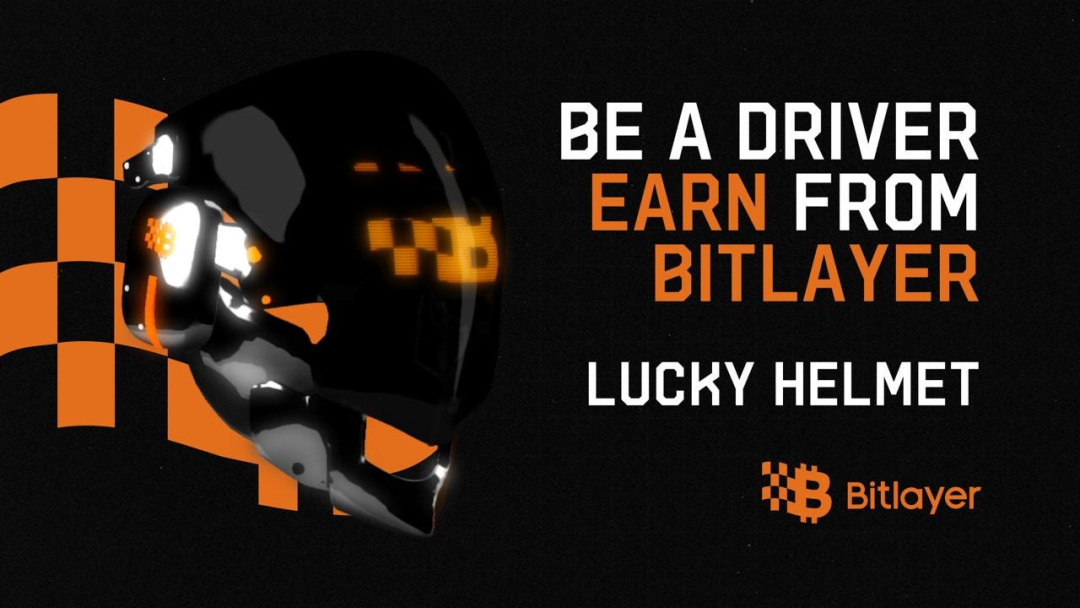
Holders of the Lucky Helmet will enjoy a range of practical rights and benefits, including priority governance rights, potential token airdrop rights, official activity points, and advantages in the ecosystem projects. Additionally, the Lucky Helmet adopts the Ordinals issuance paradigm, optimizing circulation efficiency and minimizing transaction costs.
Ways to obtain the Lucky Helmet include priority passes and public whitelist, targeting the earliest and most active participants in the Bitlayer ecosystem, as well as a limited whitelist obtained through the Bitlayer x Pionex Wallet event held in collaboration with Pionex Wallet. These NFTs will be minted within a specified time frame and need to be minted within the specified time on the official website.
Team/Partners/Funding Situation
Bitlayer was co-founded by Charlie Yechuan Hu and Kevin He.

Charlie Yechuan Hu, co-founder of Bitlayer, previously served as Managing Partner at LucidBlue Ventures and has been involved in projects such as Polygon, Tezos, and Polkadot. He graduated from Nehru Business School and Beijing Foreign Studies University. Charlie Hu has played a crucial role in expanding the influence of Tezos and Polygon, particularly as the Head of Business Development for Tezos China, and later overseeing Polygon's business in China and Southeast Asia.
Kevin He, co-founder of Bitlayer, previously served as Vice President of Technology at Xinhua Technology, Senior Technical Director at Huobi, and Chief Scientist at YOUChain. He holds a master's degree in software engineering from Peking University.
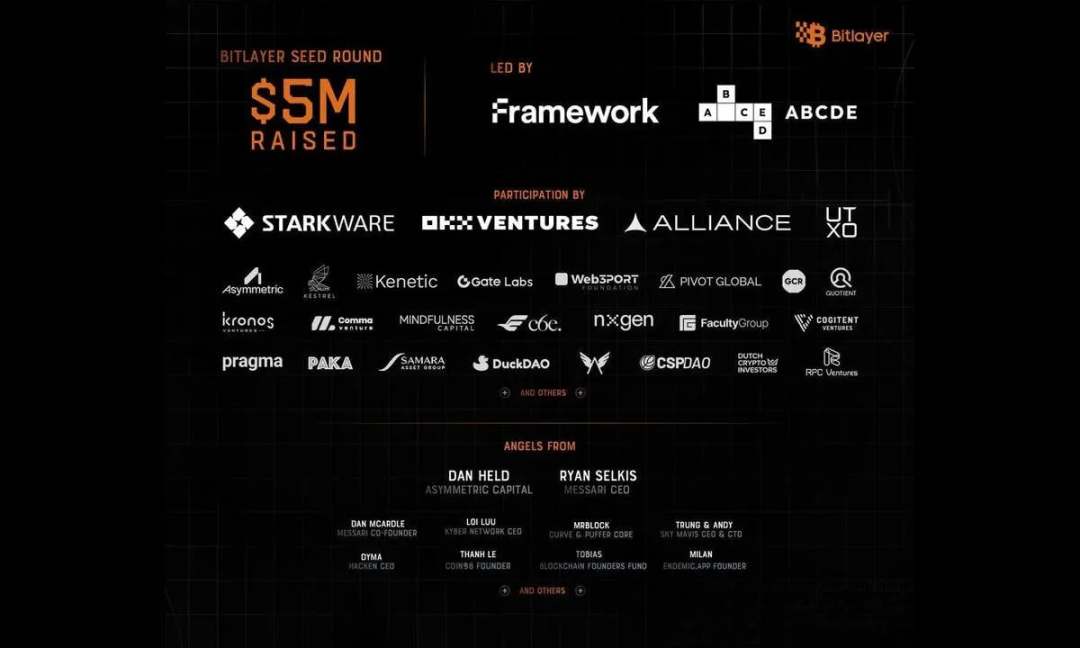
As of now, Bitlayer has successfully completed a $5 million seed funding round. This round was led by Framework Ventures and ABCDE Capital, with participation from notable investment firms such as StarkWare, OKX Ventures, Alliance DAO, UTXO Management, and Asymmetric Capital. Additionally, the project has attracted the participation of prominent angel investors including Ryan Selkis, CEO of Messari, Dan McArdle, co-founder of Messari, and Dan Held, founder of Asymmetric Capital.
Furthermore, Bitlayer announced that its $50 million developer airdrop event has attracted over 500 project teams to sign up, covering various types of projects including infrastructure, DeFi, NFTs, SocialFi, and cross-chain bridges. Within 48 hours of the event going live, over 300,000 users have voted for supported projects. The event remains open for registration until April 29, and the official competition is expected to start in mid-May, during which project teams can compete for a share of the $50 million token airdrop rewards and grants through leaderboard rankings and accelerator programs.
Project Evaluation
Track Analysis
The Bitlayer project falls within the Bitcoin second-layer solution track, focusing on expanding Bitcoin's functionality, increasing its processing speed and programmability, while maintaining its security and decentralization. The key challenge in this track is to address the scalability and flexibility issues of the Bitcoin network, enabling it to support more complex financial and commercial applications.
Similar Projects
Lightning Network: Lightning Network is one of the most famous Bitcoin second-layer scaling solutions, primarily addressing Bitcoin's transaction speed and scalability issues. By establishing payment channels, it allows participants to conduct almost instant transactions, significantly reducing transaction costs and increasing network throughput.
Liquid Network: The Liquid Network, developed by Blockstream, is a Bitcoin-based sidechain technology primarily targeting exchanges, brokers, and market makers. It supports faster Bitcoin transactions and asset issuance, while providing privacy-enhancing features.
RSK (Rootstock): RSK is another sidechain project that introduces smart contract functionality to the Bitcoin network. RSK aims to achieve Ethereum-like functionality, including support for Turing-complete smart contracts, while maintaining Bitcoin's security properties.
Target Customers
Blockchain Developers: Providing a feature-rich and EVM-compatible development environment to attract developers from Ethereum and other blockchain platforms to develop and deploy applications on the Bitlayer platform.
Enterprise Users: Providing efficient, low-cost blockchain solutions for enterprises that need to process a large number of transactions, especially those looking to leverage blockchain technology to optimize their business processes or explore new business models.
Financial Institutions: Providing secure cross-chain asset transfer and management services to help financial institutions manage, trade, and settle assets on the blockchain.
Cryptocurrency Investors and Traders: Providing a secure, fast trading platform for investors, particularly appealing to high-frequency traders who require instant trade execution and low fees.
Privacy and Security-Conscious Users: Utilizing zero-knowledge proof technology to provide enhanced security for privacy-conscious users, protecting their transactions and data from being leaked.
Project Advantages
The advantages of the Bitlayer project are mainly reflected in its unique technological innovation and strong ecosystem partnerships:
Layered Virtual Machine technology provides flexible front-end smart contract execution and back-end zero-knowledge proof generation. This layered approach optimizes the computation and verification process, improving efficiency and reducing costs.
Zero-knowledge proofs (ZKP) enhance privacy and security. Bitlayer can verify the correctness of transactions without revealing any specific transaction details, providing users with higher privacy protection.
Optimistic Verification
Optimistic Verification only returns to on-chain verification in case of disputes, effectively reducing network congestion and transaction fees.
The OP_DLC bridge achieves high security interoperability with the Bitcoin main chain. This technology allows assets to be securely locked and transferred between the two chains while maintaining complete control for users.
Bitlayer has reached intentions for ecosystem development and cooperation with over 80 projects, covering key areas such as infrastructure, stablecoins, wallet services, and others. This extensive network of partnerships provides Bitlayer users with a rich array of services and applications, enhancing the platform's attractiveness and competitiveness.
By combining technological innovation and a wide cooperation network, Bitlayer not only provides efficient and secure solutions technically but has also formed strong ecosystem support in the market. This positions Bitlayer favorably in the competitive blockchain market, laying a solid foundation for future development.
Potential Project Disadvantages
Despite Bitlayer's excellent performance in technological innovation and ecosystem development, like many technical projects, it also faces potential challenges and drawbacks. These drawbacks may affect its widespread adoption and ultimate success. Here are some of the main potential disadvantages Bitlayer may face:
Technical Complexity
User adoption barriers: Bitlayer's advanced features, such as layered virtual machines and zero-knowledge proofs, while powerful, may be too complex for ordinary users and developers to understand and use, hindering widespread adoption.
Maintenance and upgrade challenges: Highly complex systems may face more technical challenges in maintenance and upgrades. Even small errors or vulnerabilities could lead to security risks or performance issues.
Security Issues
Security risks of new technologies: Despite using advanced encryption and security technologies, the introduction of new technologies always comes with unknown security risks. For example, if zero-knowledge proofs and optimistic verification mechanisms are not implemented properly, vulnerabilities may be found.
Dependency on external systems: Some of Bitlayer's features may depend on external systems and services, such as cross-chain bridges. The security and stability of these systems may affect Bitlayer's overall security.
Market Competition
Competition with other second-layer solutions: There are many other second-layer solutions in the market, such as Lightning Network, Liquid Network, etc., which have more mature technologies and user bases. Bitlayer needs to prove the superiority of its technology and unique value to stand out in the competition.
Market acceptance and adoption speed: Although advanced in technology, Bitlayer's market acceptance and adoption speed will also be influenced by its actual use cases, user experience, and the overall market environment.
Economic and Regulatory Factors
Capital requirements: The development and operation of advanced blockchain projects require substantial financial support. Insufficient future funding may impact the project's continued development.
Regulatory uncertainty: Blockchain technology, especially projects involving financial applications, face strict and constantly changing regulatory environments. Regulatory uncertainty may affect Bitlayer's operations and expansion.
Future Plans
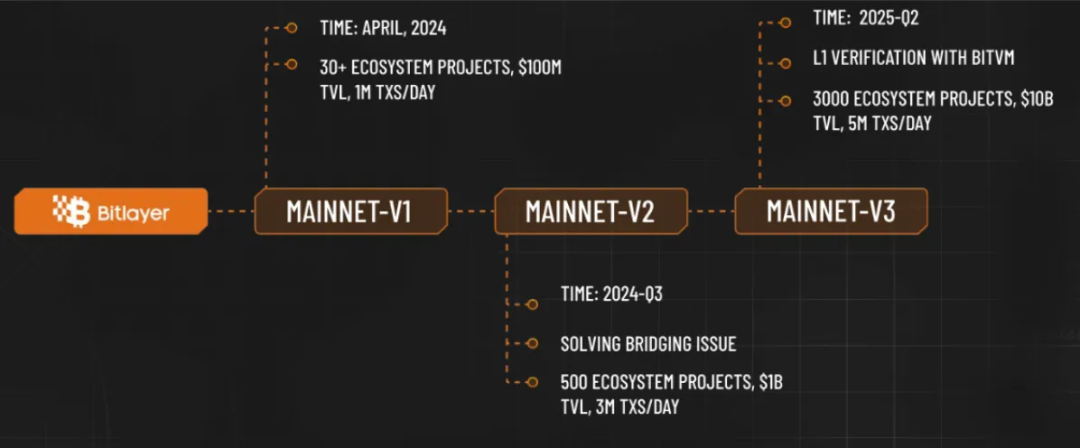
Bitlayer's development roadmap shows its major milestones in the upcoming versions:
Mainnet-V1 (expected to launch in April 2024):
- Plans to have over 30 ecosystem projects.
- Total Value Locked (TVL) to reach $100 million.
- Daily transaction volume (TXs) to reach 1 million.
Mainnet-V2 (expected to launch in the third quarter of 2024):
- Focus on solving cross-chain bridging issues.
- Expand the ecosystem to 500 projects.
- Increase total value locked to $1 billion.
- Increase daily transaction volume to 3 million.
Mainnet-V3 (expected to launch in the second quarter of 2025):
- Achieve first-layer verification with BitVM.
- Significantly increase the number of ecosystem projects to 3000.
- Explosive growth in total value locked to $10 billion.
- Daily transaction volume to reach 5 million.
Overall, Bitlayer plans to significantly increase the number of ecosystem projects on its platform, increase the total value locked in assets, increase daily transaction volume, and drive integration verification with the first-layer chain (L1) and BitVM through a series of upgrades. These goals demonstrate Bitlayer's commitment to building a powerful network, providing highly scalable solutions to support the growing demand for blockchain applications.
Conclusion
The Bitlayer project is moving towards becoming a revolutionary Bitcoin second-layer solution. Through its innovative BitVM technology and layered virtual machine architecture, it aims to significantly enhance the scalability and smart contract functionality of the Bitcoin network. As its development roadmap is gradually realized, Bitlayer is committed to expanding its ecosystem to thousands of projects, accumulating tens of billions of dollars in total value locked, and processing millions of daily transactions, which is expected to greatly drive the practicality and market penetration of Bitcoin. With continuous iterations of the mainnet, from Mainnet-V1 to Mainnet-V3, Bitlayer demonstrates its ambition to become a center of economic and innovative activities in the Bitcoin ecosystem.
免责声明:本文章仅代表作者个人观点,不代表本平台的立场和观点。本文章仅供信息分享,不构成对任何人的任何投资建议。用户与作者之间的任何争议,与本平台无关。如网页中刊载的文章或图片涉及侵权,请提供相关的权利证明和身份证明发送邮件到support@aicoin.com,本平台相关工作人员将会进行核查。




